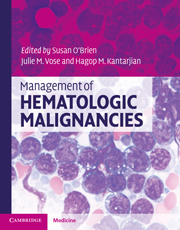Book contents
- Frontmatter
- Contents
- List of contributors
- 1 Molecular pathology of leukemia
- 2 Management of acute myeloid leukemia
- 3 Treatment of acute lymphoblastic leukemia (ALL) in adults
- 4 Chronic myeloid leukemia
- 5 Chronic lymphocytic leukemia/small lymphocytic lymphoma
- 6 Myelodysplastic syndromes (MDS)
- 7 Hairy cell leukemia
- 8 Acute promyelocytic leukemia: pathophysiology and clinical results update
- 9 Myeloproliferative neoplasms
- 10 Monoclonal gammopathy of undetermined significance, smoldering multiple myeloma, and multiple myeloma
- 11 Amyloidosis and other rare plasma cell dyscrasias
- 12 Waldenstrom's macroglobulinemia/lymphoplasmacytic lymphoma
- 13 WHO classification of lymphomas
- 14 Molecular pathology of lymphoma
- 15 International staging and response criteria for lymphomas
- 16 Treatment approach to diffuse large B-cell lymphomas
- 17 Mantle cell lymphoma
- 18 Follicular lymphomas
- 19 Hodgkin lymphoma: epidemiology, diagnosis, and treatment
- 20 Treatment approaches to MALT/marginal zone lymphoma
- 21 Peripheral T-cell lymphomas
- 22 Mycosis fungoides and Sézary syndrome
- 23 Central nervous system lymphoma
- 24 HIV-related lymphomas
- 25 Lymphoblastic lymphoma
- 26 Burkitt lymphoma
- Index
- References
7 - Hairy cell leukemia
Published online by Cambridge University Press: 10 January 2011
- Frontmatter
- Contents
- List of contributors
- 1 Molecular pathology of leukemia
- 2 Management of acute myeloid leukemia
- 3 Treatment of acute lymphoblastic leukemia (ALL) in adults
- 4 Chronic myeloid leukemia
- 5 Chronic lymphocytic leukemia/small lymphocytic lymphoma
- 6 Myelodysplastic syndromes (MDS)
- 7 Hairy cell leukemia
- 8 Acute promyelocytic leukemia: pathophysiology and clinical results update
- 9 Myeloproliferative neoplasms
- 10 Monoclonal gammopathy of undetermined significance, smoldering multiple myeloma, and multiple myeloma
- 11 Amyloidosis and other rare plasma cell dyscrasias
- 12 Waldenstrom's macroglobulinemia/lymphoplasmacytic lymphoma
- 13 WHO classification of lymphomas
- 14 Molecular pathology of lymphoma
- 15 International staging and response criteria for lymphomas
- 16 Treatment approach to diffuse large B-cell lymphomas
- 17 Mantle cell lymphoma
- 18 Follicular lymphomas
- 19 Hodgkin lymphoma: epidemiology, diagnosis, and treatment
- 20 Treatment approaches to MALT/marginal zone lymphoma
- 21 Peripheral T-cell lymphomas
- 22 Mycosis fungoides and Sézary syndrome
- 23 Central nervous system lymphoma
- 24 HIV-related lymphomas
- 25 Lymphoblastic lymphoma
- 26 Burkitt lymphoma
- Index
- References
Summary
Introduction
Hairy cell leukemia (HCL) is a rare, chronic lymphoproliferative disorder characterized by splenomegaly, pancytopenia, bone marrow fibrosis, and frequent infectious complications. Its hallmark is the hairy cell, a small- to medium-sized mononuclear cell with a typical serrated border and cytoplasmic projections. Although the World Health Organization (WHO) has codified the appellation “hairy cell leukemia,” “leukemic reticuloendotheliosis” was its historical reference in the literature. Ewald first used this term for a disease more consistent with acute monocytic leukemia. In 1958, Bouroncle et al. used “leukemic reticuloendotheliosis” to describe the clinical entity now recognizable as HCL. Eight years later, Schrek and Donnelly also reported on the same disease and commented on “peculiar cells” that had numerous short villi and were arbitrarily called “hairy cells” on phase contrast microscopy. “Hairy cell leukemia” gained popular and official recognition.
Epidemiology
HCL constitutes approximately 2% of all lymphoid leukemias. It is predominantly a male disease, with the male:female ratio ranging from 4:1 to 7:1. The vast majority of affected people are white, with Ashkenazi Jews being an overrepresented group. The median age of onset is in the early fifth decade.
Etiology
HCL has no known cause and risk factors are poorly characterized. Farming or woodworking, or occupational exposure to organic solvents, resulted in a higher relative risk for developing HCL. Infectious mononucleosis has been associated with HCL, but a pathogenic role for Epstein–Barr virus has been disputed. Studies evaluating radiation exposure as a HCL risk factor have also produced conflicting results.
- Type
- Chapter
- Information
- Management of Hematologic Malignancies , pp. 116 - 130Publisher: Cambridge University PressPrint publication year: 2010
References
- 1
- Cited by



